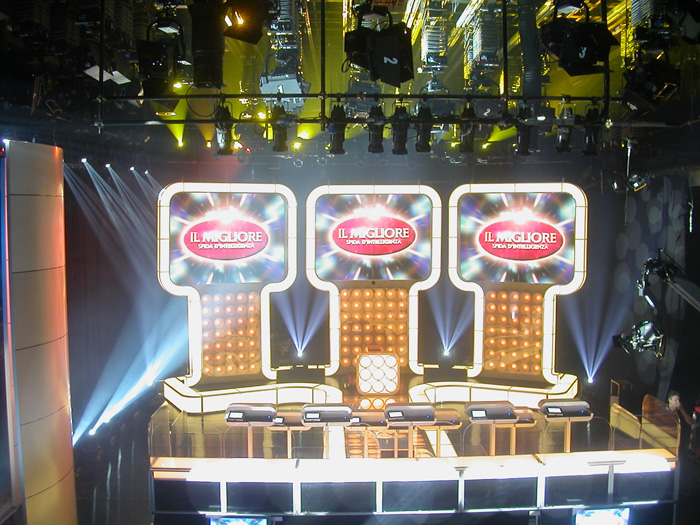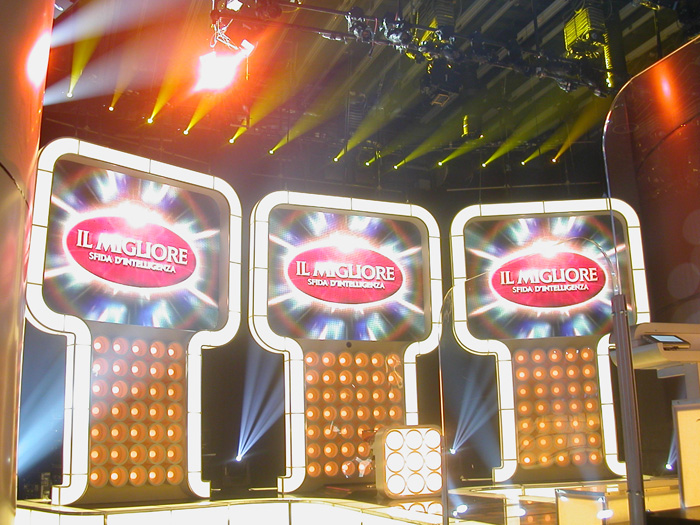“Il Migliore” is a quiz show with prizes hosted by Mike Bongiorno, which selects its contestants within specific professional categories: teachers, naval officers, engineers, pilots and archaeologists…it is a battle to the last question. The show has the objective of assigning the trophy of “brainiest person” to the best of each category, through a series of eliminatory questions which recall the format of the classic quiz show.
The program bases itself on the English format coined by the Celador production company which was broadcast on ITV1, entitled “Britain’s Brainiest”, it obtained upon its debut a fantastic viewer share of 33.5%.
It is interesting to see how modern technology can contribute to the classic quiz format and consequently coin new terms: among these, we can surely notice the particularity of certain camera shots and the simultaneous use of light, as Aldo Solbiati, Directory of Photography, explains: “At various stages of the quiz, before the commercial breaks and when we return to the studio, the “bamboo” camera follows along the entire length of the studio with a movement that encompasses the stage of the host, the 9 contestants’ podiums, and the audience gallery. This “dynamic” situation, repeated many times throughout the show, intensifies its own movements thanks to beams of light which have been studied to combine with it in the most effective way”.
The lighting system is mainly made up of Clay Paky projectors: the Alpha Spot HPE 575s. Solbiati explains why these were chosen and how they are used: “We wanted to use projectors that were equipped with every effect, and we opted for the powerful 575s, seen the limited space available in the recording studio. The choice of the Clay Paky HPE was a must, since they have shown great quality and reliability in many other Mediaset productions. As already mentioned, one of the characteristic aspects of the lighting involves the fan-like movement of graphic effects which are projected simultaneously with the movement of the mobile camera. In this way, the light assumes the properties of a coded message, and it’s as if it communicates to the audience: “when I appear, this means a new part of the quiz has begun.” This precise game of lights, which is programmed from the console, is controlled manually by the operator. It would otherwise be impossible to synchronise it with the movement of the camera”.
Other situations within the program benefit from special lighting. When, for example, only three contestants remain, a semi-transparent screen appears on the TV screen which requires an orange light to highlight the contrast. Generally, every opportunity offered by the projectors to liven the set is taken advantage of, and the light is harmonized with elements of the set (televised and in the studio) and with the audience present, in order to enrich the general image.
A final notable characteristic regards the 1:1 ratio between the frontal projectors and the contestants, who are lit from the waist up through an outlined projection. When somebody gives a wrong answer, a computerized system connected to every podium sends the lamps into standby: this light is the signal that visually underlines when a contestant is eliminated form the show.
Solbiati talks to us of the Alphas: “I am very satisfied with this product on all fronts: the chromatic rendition, luminosity and the soft and precise movements. The optical effect is very clean and transparent and this is a good thing for the colorimetry of the lamp, which remains stable”.
“Il Migliore” is a program which better than others illustrates how the new frontier in quiz shows –and by extension all TV programs – cannot be secondary to what makes the format a spectacle: the use of particular lights, the unusual camera movements, the screens that act as backdrop and that reproduce the show for the people in the studio, all work towards the creation of a great television show, full of colour, novelty and technology.










